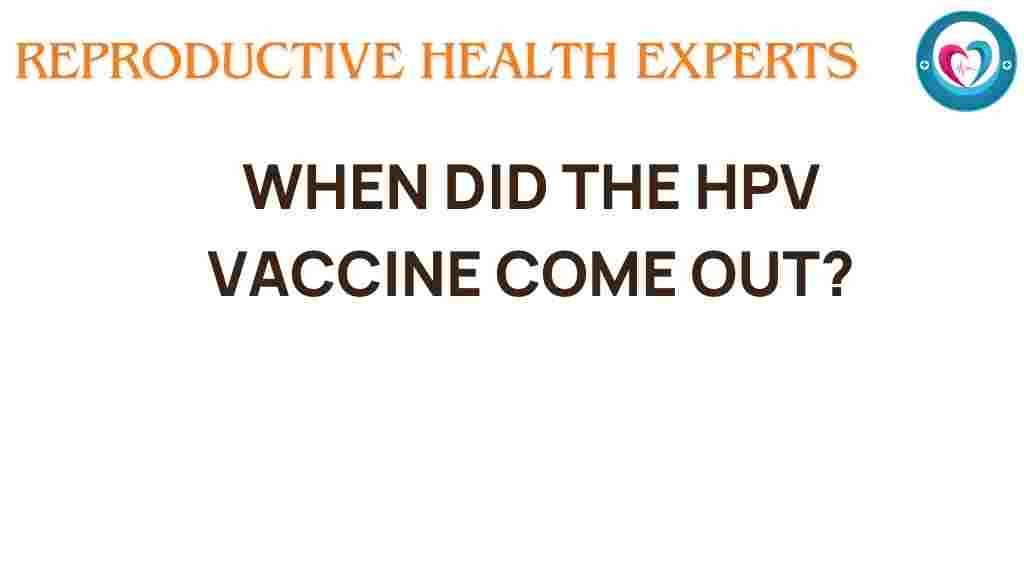Unraveling the Timeline: When Did the HPV Vaccine First Emerge?
The human papillomavirus (HPV) vaccine represents a significant milestone in public health and disease prevention strategies. Since the first HPV vaccine emerged, it has transformed approaches to immunization against cervical cancer and other HPV-related diseases. This article unravels the timeline of the HPV vaccine’s development, its history, and its impact on health awareness and disease prevention.
The History of the HPV Vaccine
The history of the HPV vaccine is rooted in extensive research and a growing understanding of the virus itself. Here’s a detailed timeline highlighting key events in the development of the HPV vaccine:
1. Early Research and Discovery (1980s)
- In the early 1980s, researchers began identifying the connection between HPV and cervical cancer.
- Dr. Harold zur Hausen’s groundbreaking work in 1983 led to the discovery of HPV types 16 and 18, which are major causes of cervical cancer.
2. The First Vaccine Trials (1990s)
- In 1991, the first vaccine trials began, focusing on the development of a vaccine that could prevent HPV infection.
- Studies on the vaccine’s potential for immunization against HPV were conducted, paving the way for future vaccine formulations.
3. Clinical Trials and FDA Approval (2000s)
- In 2006, the first HPV vaccine, Gardasil, was approved by the U.S. Food and Drug Administration (FDA).
- Gardasil protects against HPV types 6, 11, 16, and 18, significantly reducing the risk of cervical cancer and other HPV-related diseases.
4. Expanded Vaccination Recommendations (2009)
- The CDC recommended the HPV vaccine for preteens aged 11 to 12, emphasizing the importance of early vaccination for effective disease prevention.
- This recommendation marked a significant step in public health initiatives to increase immunization rates.
5. Introduction of Cervarix (2010)
- Cervarix, a second HPV vaccine, was introduced in 2010, focusing on the prevention of HPV types 16 and 18.
- This expanded options for vaccination, allowing healthcare providers to tailor immunization strategies to individual patient needs.
The Importance of HPV Vaccination
The HPV vaccine is a critical tool in the fight against cervical cancer and other HPV-related diseases. Here are some key reasons why HPV vaccination is vital:
- Disease Prevention: The HPV vaccine significantly reduces the incidence of cervical cancer and other HPV-related conditions.
- Public Health Impact: Widespread vaccination can lead to herd immunity, protecting those who are unvaccinated.
- Health Awareness: Vaccination campaigns have increased awareness about HPV and cervical cancer, leading to more screenings and preventative measures.
Step-by-Step Process of HPV Vaccination
The process of receiving the HPV vaccine is straightforward but requires awareness and commitment. Here’s a step-by-step guide:
1. Consultation with a Healthcare Provider
Before vaccination, it’s essential to consult with a healthcare provider. They can provide information regarding:
- The benefits and risks of the HPV vaccine.
- Recommended age and vaccination schedule.
- Any pre-existing health conditions that may affect vaccination.
2. Scheduling the Vaccination
Once you’ve consulted your healthcare provider, schedule the vaccination appointment. The HPV vaccine is typically given in a series of two or three doses, depending on the age of the recipient:
- For those aged 9-14, two doses are recommended, with the second dose given 6-12 months after the first.
- For those aged 15 and older, three doses are required, with the second dose given 1-2 months after the first and the third dose 6 months after the first.
3. Receiving the Vaccine
On the day of vaccination:
- Arrive at the clinic or healthcare provider’s office on time.
- Bring any necessary documentation, including vaccination records.
- Expect a brief health screening before receiving the vaccine.
4. Post-Vaccination Care
After receiving the vaccine, it’s important to monitor for any side effects, which may include:
- Soreness at the injection site.
- Fever or mild headache.
- Fatigue.
If any severe reactions occur, contact a healthcare provider immediately.
Troubleshooting Common Concerns
Vaccination can sometimes raise questions or concerns. Here are some common issues and how to address them:
1. Concern About Side Effects
Many individuals worry about potential side effects of the HPV vaccine. Most side effects are mild and temporary. If you experience persistent symptoms, consult your healthcare provider.
2. Misconceptions About the Vaccine
There are several misconceptions about the HPV vaccine, including:
- Myth: The vaccine encourages promiscuity.
- Fact: Research shows that vaccination does not increase sexual activity among adolescents.
- Myth: The vaccine is only for girls.
- Fact: The HPV vaccine is recommended for all genders to prevent HPV-related diseases.
3. Access to Vaccination
Some may face barriers to accessing the HPV vaccine, such as cost or availability. Resources are available:
- Check with local health departments for free or low-cost vaccination programs.
- Insurance may cover the vaccine; contact your provider for details.
Conclusion
The emergence of the HPV vaccine has played a pivotal role in public health, significantly advancing disease prevention efforts against cervical cancer and other HPV-related diseases. Understanding the history and timeline of the HPV vaccine can enhance health awareness and encourage immunization, ultimately leading to healthier communities. As we continue to promote vaccination, it is vital to dispel myths and provide accurate information to ensure that everyone can benefit from this life-saving vaccine.
For more information on vaccination schedules and public health initiatives, visit the CDC HPV Vaccination page. For details on cervical cancer prevention and awareness, check out this resource.
This article is in the category Prevention and created by ReproductiveHealthExperts Team

1 thought on “Unraveling the Timeline: When Did the HPV Vaccine First Emerge?”